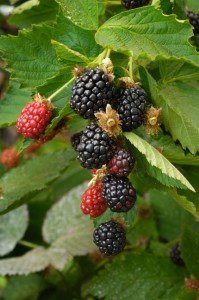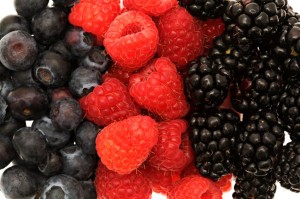In our neighborhood here in northern California, there are many places where we can forage wild blackberries from late summer into fall. When I go out to harvest wild blackberries I am reminded to be mindful of the thorns that these plants have on their stems and leaves. Blackberries are in the rose family, so it is not surprising to find thorns on these plants. Here is a nutrient analysis of one cup of blackberries (144 g):
| Blackberries – 1 cup | Adult Daily Requirements | |
| Calories | 62 | varies |
| Calcium | 42 | 1000 mg, 1200 mg |
| Iron | 0.9 | 8 mg for men and postmenopausal women, 18 mg for premenopausal women |
| Magnesium | 29 | 310 – 320 mg for women, 400 – 420 mg for men |
| Potassium | 233 | 4,700 mg |
| Zinc | 0.8 | 8 mg for women, 11 mg for men |
In reality, I eat more than one cup of blackberries in one sitting, so here is a nutrient analysis of 3½ cups of blackberries (504 g):
| Blackberries – 3½ cups | Adult Daily Requirements | |
| Calories | 217 | varies |
| Calcium | 246 | 1000 mg, 1200 mg |
| Iron | 3.1 | 8 mg for men and postmenopausal women, 18 mg for premenopausal women |
| Magnesium | 101 | 310 – 320 mg for women, 400 – 420 mg for men |
| Potassium | 816 | 4,700 mg |
| Zinc | 2.7 | 8 mg for women, 11 mg for men |
Often, people in the raw food community ask me if fruits are good source of minerals. The answer is that it depends on the fruit and how much one is eating of that fruit. As we can see, blackberries eaten in quantity can be a significant source of the minerals stated in the table above.
Not only can blackberries be a good source of certain important minerals, they are also well known for being a good source of antioxidants. Antioxidants are molecules that can neutralize free radicals before they cause damage to our cells.
A 2006 study measured the antioxidant content of over 1,000 foods and listed the 50 with the highest antioxidant content per 100 grams. Blackberries are number 19 on the list with 3.99 mmol antioxidants per 100 g. Foods that were higher than blackberries include ground cloves, oregano, ginger, cinnamon, turmeric, walnuts, basil, and others. For a full list please watch the video associated with this blog post or view the study listed in the reference section.
There is a challenge with measuring the antioxidant content of foods per 100 grams, given that one must consider how much of these foods one would actually eat in one sitting. Does it make sense that someone is going to eat 100 grams of cloves in one sitting? No, usually when one adds cloves to a recipe, the amount is usually around 1 teaspoon (2.1 grams) or a similar amount. However, it does make sense that one would eat 100 grams of blackberries (a little less than ¾ cup) or much more as mentioned earlier. When antioxidant content was measured per serving size, blackberries topped the list at 5.75 mmol antioxidants per cup, followed by walnuts, strawberries, artichokes, cranberries, and others. Ground cloves were further down on the list at number 10 with 2.64 mmol of antioxidants per teaspoon. Per serving, blackberries had the highest in antioxidants per serving than all other foods tested, which would include other high antioxidant berries like blueberries and raspberries.
What are some of the antioxidants found in blackberries? One type is anthocyanins, which are famous for their blue coloring. Other examples of anthocyanin containing foods include blueberries and raspberries.
Here is a video explaining this information with some added facts on the nutrient content of figs:
References:
Halvorsen BL, Carlsen MH, Phillips KM, Bøhn SK, Holte K, Jacobs DR Jr, Blomhoff R. Content of redox-active compounds (ie, antioxidants) in foods consumed in the United States. Am J Clin Nutr. 2006 Jul;84(1):95-135.
Nutrient content of blackberries: USDA nutrient database
But isn’t fruit controversial for some reason?
To make it easy for people to find reliable information on fruit, the glycemic index, glycemic load, fructose, glucose, and carbohydrates in general, we dedicated a chapter in our book, The Raw Food Nutrition Handbook: An Essential Guide to Understanding Raw Food Diets to answering many common carbohydrate questions.
In the book we also cover other hot topics in raw food nutrition such as essential fats, protein, nutrient content of raw food diets, food combining, enzymes, hydration, vitamins, minerals, and many more. We value education on these important topics and are happy to finally bring this book to you. The book is available on Amazon and other online booksellers.
One of the best ways to keep in touch with us is to join our email list. You’ll receive a free copy of Our Top 12 Strategies for Long Term Success on A Raw Plant-Based Diet eBook along with regular information about raw food and plant-based diets and periodic promotions for our classes, events, and other offerings!
September Blackberries
Today was an especially hot day (over 90º F) in Sonoma County and aside from the leaves on the maple tree in my front yard turning red, one would hardly guess that autumn is upon us. One of the many things that I love about northern California is late summer blackberries. Even though these beautiful and tasty berries are available throughout the summer and into the fall, I love berry picking in September since a number of the berries on a given bush are ripe and practically fall into my hands as I pick them. My favorite blackberry bush is located in a park close to my house where I find myself checking on the progress of the berries from time to time during the summer months when I pass by while out on a run or walk.

Today, I picked some to enjoy in a green smoothie. Here are some nutrient highlights of blackberries:
One cup (144 grams) of blackberries contains 62 calories, 33% of the daily value (DV) for vitamin C, 4% of the DV for calcium, 5% of the DV for iron, 7% of the DV for magnesium, 5% of the DV for potassium, 7% of the DV for zinc. One cup of blackberries also contains 184 mcg of beta carotene and 170 mcg of lutein and zeaxanthin. Blackberries have been studied for their antioxidant content, including anthocyanins which may lend a red, purple or blue color to various fruits and vegetables, such as blueberries and raspberries.

Given that one cup of blackberries contains 62 calories, which is 3% of the calories consumed on a 2,000 calorie diet, blackberries contain reasonable percentages of the important nutrients mentioned above.
Source for nutrient information on blackberries: USDA nutrient database
One of the best ways to keep in touch with us is to join our email list. You’ll receive a free copy of Our Top 12 Strategies for Long Term Success on A Raw Plant-Based Diet eBook along with regular information about raw food and plant-based diets and periodic promotions for our classes, events, and other offerings!

